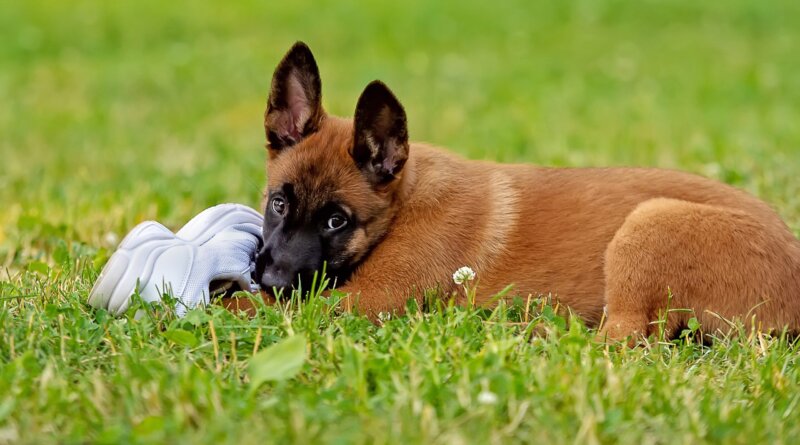How to Get a Puppy to “Drop It”
Puppies use their mouths to explore their worlds. This means that your puppy may trot into the room with something in her mouth that you don’t want to her have. Maybe it’s valuable, like your brand new AirPods. Maybe it’s precious, like your son’s favorite stuffed bear. Or maybe it’s dangerous, like a bottle of prescription meds. Whatever it is, how should you get your puppy to drop it?
It’s counter-intuitive, but if you have not yet taught your dog to “trade” or “drop it,” the best way to get the item back immediately is to give it zero attention. If there’s anything more enticing to a dog than a new thing, it’s a new thing that somebody else wants really badly! (Don’t believe me? Watch a dog suddenly care about that stupid old bone they’ve never ever chewed until the neighbor’s dog comes over and picks it up.)
The second you see a forbidden item in your puppy’s mouth, spring into action . . . elsewhere! Make your puppy suddenly think that the item is worthless because 1) you aren’t paying attention to it, and 2) you seem to be doing something else that’s really exciting. Humans aren’t the only ones who experience FOMO (Fear Of Missing Out).
Leap up. Skip to the kitchen singing the, “I’m getting out the ham” song. Be goofy. This alone (provided it doesn’t happen all the time) can be enough to startle your dog into dropping the item.
If that happens, do not run back to the scene of the crime, grab the item, and give a big lecture about how he’s never to do this again. You will have undone all your good work! Instead, prove to your dog that it always pays to see what you’re up to when you’re acting goofy: Give him that ham you grabbed from the fridge. Ask for some sits and spins and downs, and reward with that ham. Then do a kibble scatter on the floor so it’ll take him a little while to clean up, and then slip out to quietly grab the item and put it up high. Phew! Done.
Another option is to make a treat trail. Make a little path of ham bits starting right at your puppy’s feet and heading away from the item. (You can’t eat ham and maintain possession of the prescription sunglasses.)
Offering up a special tug toy might do the trick for your tug-obsessed dog. Or, if your dog is in love with a neighbor’s dog, it might work to announce an immediate trip next door for a play session. Your knowledge of your dog will help you figure out what will create the FOMO elsewhere that will make him drop the item.
What Not to Do
Maybe the approach above strikes you as silly, when you are inclined to choose a more direct or even stern approach. Before you do that, be aware that the strategy you use might spell the difference between a dog who constantly looks for “bad” things to pick up in her mouth, and one who never develops that habit. The wrong response to a dog who loves to pick up stuff could very well promote the development of resource-guarding behaviors – a bigger problem than losing a few items to chewing. Serious resource guarding calls for help from an experienced force-free trainer.
Many people instinctively try the yell-and-grab method, chasing down the pup and physically extracting the item from the puppy’s mouth. After all, every second counts when it comes to either damage inflicted to the item or danger to the pup from ingestion.
But is the yell-and-grab really the fastest, safest way to retrieve the item? Nope. Even if it works in this particular moment, you’ve set yourself up for trouble. Here are some likely unintended and unpleasant outcomes of this approach:
- Seeing your approach, puppy knows she has just seconds to work with, so she gobbles quickly instead of just playing with the item. Now that chicken bone she found under the bush in the park is down her throat. What did pup learn? Nothing, but you’ve now got a big vet bill.
- The pup is delighted with her newfound attention. Pup runs and scampers, staying just out of reach, having a blast! What did pup learn? “To have a super happy time with Mom, just grab something that’s not a puppy toy!”
- The pup is scared of your shockingly big mad voice and fast movement, so she runs and hides under the couch. It takes a long time to get her (and the item) out. What did pup learn? “Don’t ever trust Dad; he’s unpredictable!”
- The pup begins to realize that you are constantly trying to steal her special treasures, so she goes on the offense, growling and snapping. What has she learned? “These people take all the good stuff, so be ready to fend them off.” This last one is serious; you may find out too late that you have inadvertently contributed to the creation of a resource-guarder; you’ll need a good force-free trainer to help deal with this.
Using a Cue for “Drop it”
If you have invested time in teaching your puppy that giving something up to you will pay off for her, then you’re all set for this key moment. You can calmly use the cue you’ve taught (either “drop it” or “trade”), your pup will relinquish the item and receive a reward, and you’ll be on your way.
But what if you’re not there yet? In that case, start working on those behaviors now, so you’re ready for next time. See “How to Teach Your Dog to ‘Leave it’ and ‘Drop it’” WDJ May 2023.
Prevention Skills
Sometimes people hear the description of the skip-and-sing approach and say, “Come on! My puppy grabs stuff all day long! I can’t do this whole shebang every time!”
It’s quiz time! What is wrong with the sentence, “My puppy grabs stuff all day long?”
You get an A+ if you answered: “Any self-respecting new puppy will grab anything interesting in his path, especially when bored. It is up to the people who took him from Planet Dog to create a safe environment for him here on Planet Human. That means gates and crates, careful supervision, plenty of exercise, and puppy-appropriate enrichment.”




